Dec 8, 2014 to Dec 8, 2015
One year ago today (Left picture, below), I was both angry and frightened – the worst of emotional combinations. I was angry at myself for lacking the self-control to stop my incessant weight increases.
 I was frightened by failing health and medical opinions of gum disease and impending diabetes. Plagued by debilitating knee and low back pain. The prescription of my rail-thin doctor for 30 years had been the same, steady drumbeat of “Eat less, Exercise more.”
I was frightened by failing health and medical opinions of gum disease and impending diabetes. Plagued by debilitating knee and low back pain. The prescription of my rail-thin doctor for 30 years had been the same, steady drumbeat of “Eat less, Exercise more.”
Despite seldom-ending self-imposed diets, and programs costing several thousands of dollars over the years, with a few short-term exceptions, weight increased. The montage of spontaneous photos below shows my weight history prior to Wheat Belly. . .
. . . (click to enlarge)
There was the 10 week period in 1988 when I lost 50 lbs (225 to 175) on a low carb, low fat, low calorie Quick Weight Loss program (now Slim4Life). I did not do well on “maintenance” and quickly regained 20 lbs. By 1990, I weighed more than when I began the QWL program – somewhere in the 230s. Weight bounced up and down – mostly up despite Jenny Craig, SlimFast, and bouts of jogging/running. At the beginning of 2010 I found myself at 270.
My wife and I signed up with Slim4Life in January 2010, and over the next 5 months, I lost 42 lbs. (270-228). A year later, I was back to 270.
In preparation for a job change in 2012, and weighing 265, I re-engaged Slim4Life. I lost 30 lbs (235) in three months and plateaued for a month. Out of frustration, I joined my daughter in the new HCG craze, and lost an additional 15 lbs (220) in 3 weeks, my lowest weight since 1988. During the required 1-week pause between rounds of HCG injections, I regained 10 lbs. I didn’t have the heart to return to HCG injections and 500-calorie days. In less than a year was back to 270.
The last major attempt at weight loss was in the spring of 2014, following a Slim4Life regimen on my own. I lost 18 lbs and enjoyed a 252-lb vacation in California surf. But the new fall school term – with increased stress and New Orleans’ “goodies” – found increasing weight again. My blood pressure, LDL cholesterol, and triglycerides were all high. HDL was low. Despite sporadically taking antioxidants (C, E, D, and even Astaxanthin) as well as garlic, curcumin, CLA, and alpha-lipoic acid, weight crept upward.
By November 2014, I was in serious trouble. I was back to 270 lbs, a recurring “ceiling weight” of sorts. A dentist appointment brought news of receding and deteriorating gums (inflammation). I suffered from constant pain in both knees and my lower back — walking was difficult and standing more than a few minutes was worse. A trip to Disney World with the family underscored my condition: required “sit breaks” every 10-15 minutes of walking, leg cramping – especially in my quads — while standing in long lines. The only relief was Blue Emu oil applied 2-3 times a day. My annual physical that month brought more bad news. My doctor predicted that our next conversation would be “learning to live with diabetes,” because “you are that close.”
The doctor, dentist, and physical pain at Disney provided three tall shots of fear. A week later, on Sunday, December 7, Pearl Harbor Day, the scales served up a gutful of anger. I had returned the day before from a teaching trip to New Orleans suffering from the stress of long days, sitting, fried oyster and shrimp po’boys, and – the coup degras – a batch of pralines picked up for the family and “tasted” at the NOLA airport.
Sunday morning, I drug my stiff body out of bed and stepped on the scales. Despite using hand pressure on the towel bar to “ease into” my final digital weight, the scale read “276.7,” a new high lifetime weight. I was ready to hurt something or somebody. And at the same time, I felt as close to hopeless as I can ever remember.
Fortunately, I had had lunch with a long-time friend two weeks before, just after my doctor’s appointment. I had complained about all the above, and he told me about Dr. William Davis and the Wheat Belly Facebook page. He and his wife, a registered nurse, had had a litany of medical problems, including incessant weight gain, two years before. They adopted Wheat Belly, and within a few months, their medical issues had been resolved. During the first year, he lost 40 lbs, and his wife 30 – putting them back to their college weights. A week later I received the books Wheat Belly Total Health and The 30-Minute Cookbook – his gifts to me for improved health. I read Total Health off and on, but I was busy, so set them aside. “Give up bread?” I wasn’t quite ready for that. But on that Sunday morning, as I stepped off the scales, Wheat Belly leaped to the top of my mind, and I was ready. I ate no bread or grains that day, the first day of my Wheat Belly lifestyle.
The next morning I was a pound down (275.7). The next 6 mornings reflected losses of -2.5, -1.6, -2.2, -2.2, -2.4, and -2.6 lbs. Late on Day 5, I was hit with Wheat Flu. Days 6 and 7 was spent in bed with a 102-degree temperature. On the morning of Day 7, my fever broke and I returned to the land of the living. I weighed 260.6 (-16.1 lbs). All of my knee and low back pain was gone. All cravings for sweets and pastries was gone. I had little appetite, but still enjoyed eating. Best of all, I just felt better than I had in years. (All of these first-week benefits have continued unchanged over these 12 months on WB. While I have had issues with plateaued weight, the physical improvements related to inflammation have continued long-term, as I’ll describe.)
Weight loss continued to the end of 2014. On the last day of the year, 26 days after beginning WB, I weighed 250.2 (-26.2 lbs). I was thrilled.
Over the next four months, however, I experienced the frustration of bouncing daily weights, and sweeping gains and losses between a low of 248 (February) and a high of 258 (April). Then through April, May, and June, I experienced a long weight loss period, ending on July 2 at 238 lbs – a loss of 39.6 lbs over seven months. This is the longest, most consistent period of weight loss in my life. Considering monthly averages (circled lines), I had only one month of inexplicable gain (March) out of seven.
During these months I learned, perhaps for the first time in my life, just how difficult fat loss is. How many times had I lost “10 lbs in a week.” Or, more correctly, lost 9 lbs of water and a pound of fat. You can see by the daily weights how “fluid” my journey was. Weeks of jittery losses followed by weeks of jittery gains.
When I hit 238 on July 2, I thought to myself, “I’m on my way now!” All I could see was greater losses into the 220s and 210s. Expectations were high.
The reality, however, was far different. I had been merely on a stroll in the foothills. Now I faced the mountain.
What followed in July was not greater losses, but steady increases. By August 3, my weight had climbed from 238 to 251, a gain of 13 lbs.
I analyzed my foods and concluded that, while WB-compliant, I was eating too many “legal WB carbs” (not always hitting below 50 grams per day), and snacking too much between meals – usually on almonds or peanuts.
I read about “Eat-Stop-Eat” (no snacking between meals, and periodic fasting for 12-, 16- or 24-hours. I had initial success (lost 7 lbs in 14 days), but this too turned to another bounce (gaining 5.4 lbs in 4 days).
A whiny WB post brought the recommendation from Dr. Davis to “try ketosis.” Following his advice, plus the help and support of regular WB posters Ron, Zandaria, Fred, and Elizabeth, as well as the well researched book Keto Clarity (Jimmy Moore), I began Nutritional Ketosis, or what I have come to see as “Wheat Belly on Steroids” on Sep 8.
I cut my carb-protein-fat ratios down to <5%, 15%, >80%. After months of plateau, you can see I began bouncing down instead of bouncing in place.
In mid-November, I hit “238” for the third time this year, and had high hopes of finishing my 12th month on WB+ with another sizeable loss. Instead, touching 238 for just a day, I rebounded for 14 days, gaining 6 lbs, up to 244 lbs.
While in New Orleans for a teaching stint December 1-5, I ate one WB meal a day, a breakfast of BPCoffee and a lunch of Swiss & Butter mini-sandwiches. I achieved high ketogenic ratios, lower calories, and a loss of 6 lbs in 5 days! Returning home, we had two family celebrations, and I ate more (legal) carbs than normal – 70 grams on one day – and more protein than I should have. Weight, of course, has spiked again due, most likely, to water weight.
In years past, I would have been discouraged by all this. I would have jettisoned NK and WB and just ate as I pleased. But the problem is not WB or NK, nor is the problem my lack of resolve. The problem is the inherent, complex difficulty that insulin-resistant folks have in burning off stored fat.
I have learned to look for the positives, and here is the positive in this most recent bounce: My first “238” (July 2) was followed by a month-long 13-lb gain. My second “238” (Sep 28) was followed by a 9-day 8-lb gain. My third “238” (Nov 20) was followed by an 8-day 6-lb gain. This morning, Day 366 on WB, after a dip back to 241, I weighed 244.7. The rebounds are shorter and smaller. That’s progress.
That said, I was reminded this week while re-reading Keto Clarity that NK is not per sec a weight loss diet. It is used primarily to repair damage done to the liver and pancreas by inflammation caused by high levels of blood glucose and high insulin levels (locking fat away in cells) over time. NK is the best prescription for reducing blood sugar and corresponding insulin levels. By eating very low amounts of carbs, the body switches from burning glucose (carbs and sugars) to ketones (fats) as fuel. With greatly-reduced insulin in the blood, the body can unlock the fat stored on the body, and use it as fuel – if calorie intake produces a deficit.
Side note: Research is showing that NK hinders the growth of cancer cells, which feed on glucose. Normal cells can switch from glucose (if absent) to ketones as a fuel source, and thrive. Cancer cells cannot, and simply starve in the absence of glucose. The effectiveness of NK varies, depending on the type of cancer, but this discovery provides another level of motivation to lose grains and sugars, limit protein, and focus on healthy fats.
WB and NK advocates often say that there is no need to count calories. “Simply eat high fat and low carb until you are satisfied.” That advice does not apply to me, because I have found I eat for reasons other than hunger. These reasons are psychological, not physiological – meal time triggers, social triggers, family triggers. It is a completely different area of battle, and one I was unaware of until WB relieved me of carb cravings and ravenous appetite.
So I have discovered my problems with consistent weight loss stem from (1) lack of personal consistency in all factors – water? Sleep? Stress? Supplements? Exercise? Macro-ratios? Keto ratios? And (2) the actual metabolic mountain of forcing the body to eliminate its own stored fat. I have found WB and NK very helpful in the struggle.
NK takes Wheat Belly’s Low-carb, High-fat guidelines a bit farther.
High fat consumption (olive oil, grass-fed butter, lard, bacon grease, coconut oil, as well as fatty meats, dark meat chicken with skin, bacon, avocados, whole eggs, cheese) eliminates carb cravings and reduces appetite significantly. Eating high fat foods permit going longer between meals – up to 24 hours – with only water or an occasional Bullet Proof Coffee. My goal is 80%+ of my calories from healthy fats.
Very Low Carb consumption reduces blood glucose and – along with it, insulin. My goal is less than 5% of my calories from carbs. Advocates of NK use raw carb counts and not net carbs (grams of carbs – grams of fiber). This results in the consumption of even less carbs. I find this low level of carbs difficult to achieve for long periods of time, but I’m getting better.
Moderate protein. It is easy to eat too much protein to compensate for very low carb consumption. It was surprising for me to learn that the body converts excess protein to glucose, which increases insulin and knocks the body out of ketosis. Jimmy Moore remarks that each of us must determine our level of protein “tolerance” for ourselves. My goal is 90-100 grams of protein per day. This is a challenge since it is easy for me to eat 130-150g per day while trying to “get in the fat.” A slice of Swiss cheese wrapped around a Tb of butter helps with 0 carbs and 5g of protein. It is sweet and creamy, and keeps me satisfied for hours. Bulletproof coffee (Tb coconut oil, Tb grass-fed butter, 10-12 oz coffee, 2 packets Truvia, blended into a latte) is the best with 0 carbs and 0 protein. This delicious beverage energizes without impacting glucose or insulin levels at all.
Calorie deficit. I count calories because I will overeat if I do not. I burn somewhere between 2300 and 2600 calories a day, depending on my activity level. If I eat 2300+ calories at 5%-80%-15% (achieving a good ketogenic ratio), I may not lose weight because my calorie deficit is so small. I say “may not” because, as I’ll explain just below, monthly averages of KRs and weights over the last 12 months produced a rather strong negative correlation between the two — that is, increases in calories are associated decreases in weights. It is certainly the case that one can gain weight on NK by eating too many calories. But it is an absolute miracle that we can force the body to eat its own fat by Nutritional Ketosis and appropriate calorie deficits. My love for Wheat Belly remains intact because it was a necessary step to break me away from the Standard American Diet (SAD) to NK.
The following set of graphs show the relationship between various factors and average weight by month. Blue bars represent months on Wheat Belly; green bars on Nutritional Ketosis.
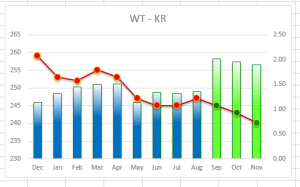 Increase Ketogenic Ratios to decrease weight?
Increase Ketogenic Ratios to decrease weight?
Yes. The jump in Ketogenic ratios in Sep, Oct, and Nov are strongly associated with decreasing average weights.
When average weights and KRs are correlated for the year, we get r= -0.57, a moderately strong negative correlation. “As avg monthly KR increases, average weight decreases.”
We also see from this chart that Wheat Belly proper is mildly ketogenic (blue bars) and is obviously associated with weight loss as well. It remains the fact that producing higher KRs broke the upward weight trend in Jul and Aug, and then produced small but consistent monthly weight loses. (Thank you, Dr. Davis, for advising me to “try ketosis”!)
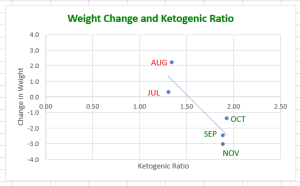 The association between KR and weight is even more stark when we plot weight changes against KR values.
The association between KR and weight is even more stark when we plot weight changes against KR values.
The weight gains in Jul and Aug are associated with weak KRs (~ 1.3), and the weight losses of Sep, Oct, and Nov are associated with stronger KRs (~ 2.0). The sharp blue line between the two clusters emphasize this. Caveat: this relationship does not hold true for weight change and KRs under WB from January through June where weight changes are associated with factors other than weak KRs.
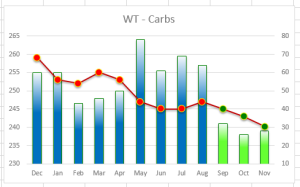 Decrease carbs and lose weight?
Decrease carbs and lose weight?
Yes. The plateaued months of May through Aug correspond with the highest average carb intakes for the year. Each of these months averaged carb intakes above 50 grams per day. This is the top limit for carb intake for WB.
NK cut carbs drastically in Sep, Oct, and Nov – and average weight dropped. When treated as data points, avg wt and avg carbs produced a moderately strong positive correlation coefficient of r = +0.31. “As carbs decrease, weight decreases.” [And vice-versa]. This one graph demonstrates rather clearly how sensitive to carbs I am.
 Increase fat consumption and lose weight? Yes, so long as carbs are low and protein held to moderate levels (=NK).
Increase fat consumption and lose weight? Yes, so long as carbs are low and protein held to moderate levels (=NK).
r = -0.58. “As fat increases, weight decreases.” (Given very low carbs and moderate protein).
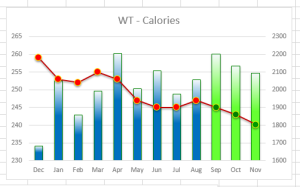 Increase calories and lose weight?
Increase calories and lose weight?
Yes, (What?!) so long as those calories are associated with fat, are not derived from carbs or excessive protein (=NK), and are not greater than calories burned during the day. (Oh, OK)
r = -0.60. “As calories increase, weight decreases.” (So long as those calories are predominantly healthy fats calories).
Notice the average calorie levels are roughly 2200, 2130, and 2100/day for the three months. Toward the end of November and early in December, my intake has increased to 2400-2600, and that from excessive protein. My recent weight gain of 6 lbs may well be explained by these raised blood glucose and insulin levels, and the lower ketone levels.
This may sound contradictory to the earlier suggestion to “limit calories to create a deficit,” but it is not. Increased fat calories within a WB or NK environment is associated with decreased weight. However: Continue to increase intake calories until they surpass calories burned by body functions and activities, and weight will increase over time.
Let’s look at one more diagram related to NK.
This graph reflects daily KRs for the 365 days I have been on Wheat Belly. The diagram reads right to left and top to bottom. KRs are displayed with the following colors:
Red blocks = no ketosis (<1.00).
Salmon blocks = weak ketosis (1.00-1.50)
Yellow blocks = strong ketosis (1.50-2.00)
Green blocks = very strong ketosis (>2.00)
I was surprised by the number of yellow and green blocks in Wheat Belly months prior to NK, showing WB to be mildly ketogenic.
Plateaus and gains in May, Jun, Jul, and Aug correspond to the numerous red blocks in those months.
Since beginning the NK approach to WB, I have achieved far more yellow and green blocks. The secret of fat loss for me is higher KRs with consistent calorie deficits and moderate protein (90-100 g/day). Oh yeah, and drinking plenty of water. Oh, and getting enough good quality sleep (it’s 2:30 am right now). And . . . and . . .
This next graph shows average monthly weights for the year. The December 2015 weight increase, based on the first 8 days, comes, I believe, from excessive protein.
My weight on December 6, when the picture was taken (238.4), has bounced up to 244.7 (+6.3 lbs) in 3 days!
It is frustrating as it can be, but I look at this graph above and remember my state of health 12 months ago – inflammation, joint pain, deteriorating gums, diabetes knocking on the door – and small weight bounces like this concern me far less.
This next overview tracks changes in appearance over the year. Many of you have seen this display progress through the year.
The pictures over the last 6 months of 2015 do not show much change, but when I superimpose the Dec 6 photo over July 7, I find the width of my face has decreased nearly a half-inch on each side. The change surprises me, given a “mere 6-lb weight difference.”
The best numbers on the chart, however, are the snapshots of lowering fasting blood glucose, from 116 (Oct), to 107 (Nov), to 103 (Dec – see monthly averages below).
My blood sugar in November 2014, before beginning WB, was 145 (pre-diabetic, said my doctor). I began consistent glucose testing in January, and had many readings in the 130s, some in the 140s. WB slowly lowered these into the 120s and 1-teens. NK has produced numerous readings in the 100s, several in the 90s, and 2 in the 80s. This is a confirmation of higher blood ketones, though inconsistency with controlling protein consumption is holding me back.
From June to November, monthly BG averages dropped regardless of weight gain or loss.
Jun 129
Jul 124
Aug 118
Sep 116 <= NK began
Oct 112
Nov 107
NK dropped glucose numbers continuously through Sep, Oct, and Nov. This is all good news, though I still have a long way to go. I understand this to be caused by my liver, which continues to dump stored glycogen into the blood stream, raising glucose levels (and corresponding insulin levels) above normal. This happens worst overnight, resulting in the highest blood glucose readings in the morning. Continued VLC eating and periodic fasting are my weapons of choice.
I just received today (Dec 9) a copy of the blood work done at the doctor’s request on Nov 20. Though I asked for a repeat of the metabolic panel done in October 2014 and April, the “system” chose what tests “they” decided I needed (“Thank you ACA”), so my analysis window is narrow. In January, I’ll go 3rd party and pay to have the tests run I need. But here is a picture of Oct 2014 (pre-WB), Apr 2015, and Nov 2015.
Total cholesterol is up. Triglycerides are down from April (thank you NK) but still “too high”. Dr. Davis and others indicate this is normal during weight loss on WB. My doctor insisted on trying to lower these numbers with Fenofibrate 160 mg, and only smiled as he assured me he had seen no problems in patients taking this statin drug.
HDL is up and normal for the first time since March 2012 (Hallelujah!), when I was moving toward a final low weight of 220 on HCG (achieved in May 2012), and run-walking 7 miles 2-3 times a week. My knees stopped the running in the Fall 2012 as I moved from 247 to 270 on the Standard American Diet.
A bit worrisome for me are LDL and VLDL numbers. LDL actually increased from April (79, normal) to November (107, range 0-99). VLDL (not measured before) is 69, above the upper limit of 40. One of the characteristics of WB is lower LDL numbers, so I do not know what is happening there.
Elements in the report that are not reflected on the comparison chart include magnesium (normal @ 2.1, range 1.6-2.6), Ferritin (normal @ 295, range 30-400), hemoglobin (normal @ 15, range 12.6-17.7), and CRP, an inflammation indicator (high @ 5.3, range 0.0-4.9). Would be nice to have a comparison number for this. My guess is that this number has dropped, since general inflammation has dropped over the year.
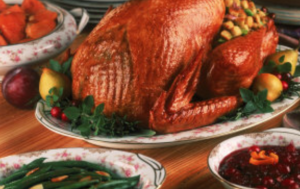 Christmas offers no worse “nutritional dangers” than did Thanksgiving, and I feasted right along with the family while maintaining NK.
Christmas offers no worse “nutritional dangers” than did Thanksgiving, and I feasted right along with the family while maintaining NK.
Well, mostly :>).
I had two servings of a WB legal pumpkin pudding with whipped heavy cream (a blessed thing), but the carbs in the pumpkin puree moved me beyond NK guidelines.
We cleared the greatest family feast day hurdle last year on Christmas Eve when I enjoyed fried oysters (almond flour, coconut oil) and oyster stew (oysters, cream, butter). The rest of the family ate traditional fried oysters (wheat flour) and (wheat flour) crackers in their stew — then took the manditory carb-nap before dinner.
~~~
I come to the end of Year 1 of WB/WB+ with a far greater understanding of the complexity of fat storage and fat loss. I’m still learning. Still struggling with psychological and social food triggers that have nothing to do with hunger.
I’m still working on “keeping all the balloons in the air” – carbs, protein, fat, gut bacteria, water, calories, supplements, exercise. I find myself doing well in most of these in various combinations, but seldom all of them simultaneously. Through it all I have maintained a “No grains – No pains” lifestyle, and I am in far better health than I’ve been in decades.
Twelve months ago, I stood with my PhD students for a class picture (top below). It was Saturday morning, Dec 6, the day before “Pearl Harbor Day” when I began Wheat Belly. The second picture was taken in the same place with another class of PhD students — on December 5 of this year. Look! While the crowd hides my Wheat Belly in the first picture, you can see my belt buckle in the second!
Today (Dec 9) is Day 1 of WB Year 2. That, in itself, is a great accomplishment for me. You all have been an integral part of the journey – your stories and pictures, encouragements and suggestions, have had a tangible influence on my success. I thank God for you all, and for the health and well-being I have to continue my teaching ministry as I approach the beginning of the 8th decade of my life.
I’ll continue to report month by month. Given 2015, I could find myself breaking the 200-lb barrier a year from now. Given the last 6 months, I could just as easily hit “238” umpteen times in the next 12 months! But I’ll keep learning and sharing and overcoming right along with all of you.
My wife hinted recently that she might just jump on this train with me. Now that would be the ultimate sugar-free icing on an almond flour cake!
See you next month!


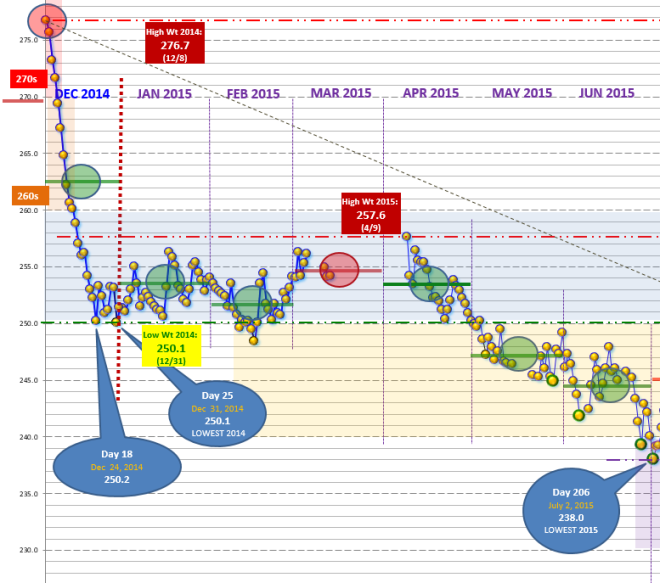

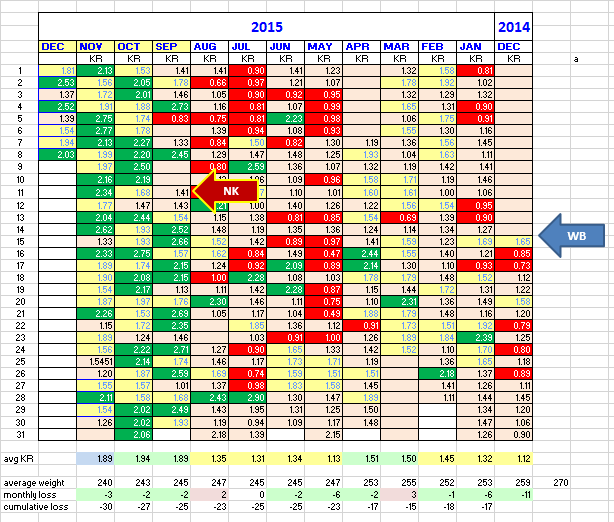

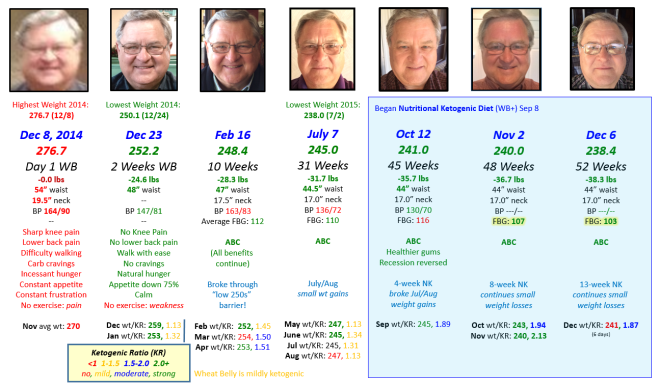


Wow. Your writing is a tour de force. This is all very new to me except for the “out of control gaining weight” feeling. I have started the WB diet but haven’t even gotten all the necessary non-wheat foodstuffs for cooking. I am losing weight but have been alarmed by high heart rate and bp.
There is a lot to learn from your post, esp. the concept of KR, and some of the resources including MyFitnessPal. A suggestion- I was confused as a novice by some of the acronyms- KR, NK. Maybe you can define the terms so this is easier to follow for those new to this arena.
You have done an outstanding job of teaching. I too am a teacher- in a more unpredictable setting (autistic students from 14-21), and succeeding at this means the ability to hang in there and continue working.
Thanks and HNY2U
Steve Boswell
LikeLike
Steve,
Thank you for taking the time to post. I originally wrote the piece for folks on Dr. Davis’ Facebook page who are generally familiar with the terms. But your point is well-taken.
KR = ketogenic ratio. It is derived from a formula analyzing macro-nutirents carbohydrates, protein, and fat. There is a free calculator that I use daily at http://www.flexibleketogenic.com. It is an easy way to determine how “ketogenic” (fat-burning) one’s food intake is.
NK = Nutritional Ketosis, an eating lifestyle that intentionally places the body into a state of ketosis, the natural state of anyone deprived of carbohydrates for more than 24 hours. The body automatically switches to ketones as fuel when carbohydrates are limited (an added benefit is the discovery that some types of cancer cells cannot make this switch, and therefore simply die under a ketogenic system.
[note: Many doctors mistake Nutritional Ketosis with Ketoacidosis, a dangerous life-threatening condition experienced by Type 1 diabetics (unable to produce any insulin). The condition is defined by high ketones in the presence of high glucose (140 +). A T2 diabetic, pre-diabetic, or normal individual (all of whom produce SOME insulin) *cannot* fall into ketoacidosis because as glucose rises, insulin rises, and ketones decline. As glucose falls, insulin falls, and ketones rise — a strong negative correlation. KETOSIS is merely the state in which the body burns fat as fuel. A ketogenic diet prohibits the body glucose, and forces it to produce ketones “naturally.” It is perfectly healthy, as research going back to the late 1880s shows. Dr. Adkin’s famous diet of the 1970s and 1980s was ketogenic, but he and his work was smeared by those – without scientific study — who assumed eating fat causes fat. USDA guidelines released in the 1970s promoted “6-11 servings of grains per day,” of which “50% should be whole grains.” The USDA food pyramid also called for limited fat consumption. What has followed has been 40+ years of rapidly increasing obesity, diabetes, heart disease, and cancer. All have associations with “eat grains, limit fats.”]
NK is Wheat Belly extreme, or WB+ as I call it. Davis (WB) encourages increasing “healthy fat” consumption while eliminating grains, grain by-products (modified food starch, maltodextrin, etc) and refined sugars, as well as restricting carb intake to less than 50 grams / day.
NK agrees with WB but goes farther: recommends “very low carbs, moderate protein, and high fat.” In terms of percent of calories, this translates roughly to ~5% carbs, 15% protein, and 80% fat (Each individual need to tweak this for his/her body. Moore shows how.
Dr. Davis (WB) recommended I “try ketosis” when my weight loss efforts under WB stalled. It was a good call.
Since my update, I corrected some drift into higher carbs (25-35 g / day) and higher protein — resulting in a 6-lb weight gain — and have achieved a reasonable steady weight loss over the last three weeks of 12 pounds. That is amazing for me, given 13 months of WB and NK. Yesterday morning I hit a new low weight since beginning WB in Dec 2014, some 45 lbs down.
If weight loss is your primary goal, look to NK more than WB since lower carbs in NK will burn fat off your body faster. Davis’ title “Total Health” is desciptive. There are many good things happening in a body on WB, and weight loss is simply a byproduct of those. I lost 25 lbs the first 24 days, but then lost “only” 13 more the rest of the year. Burning fat off of the body, especially if you suffer from insulin resistance (pot belly, man boobs are the two “easy tests” for IR). Jimmy Moore states in his must-read “Keto Clarity” he did not begin producing ketones until he hit 80% fat over several weeks. The chemistry of the human body is just too complicated for IR folks to “eat less, exercise more” and succeed. IR literally locks fat away and forces the liver to dump sugar into the blood stream for fuel (which is then converted to fat and stored by insulin). Whether we eat or don’t eat, we get fatter.
FASTING is the only solution. High fat zaps appetite and hunger, allowing us to fast longer and more frequently. “Very low carb” forces the body to switch to ketones for fuel. Fasting creates calorie deficits, forcing the body to eat its own fat as fuel. Ketones protect muscle from being broken down (debunking the myth of losing muscle under ketosis, which actually does occur in standard low calorie diets). Ketones protect neurons (brain cells) from oxidation, supporting good brain health. I fast 12-hours every day. From supper to breakfast, 7pm to 7am. No snacks. No legal foods — no food at all. I often fast 16-hours, “8pm – 12 noon.” I will sometimes have a Bullet Proof Coffee for breakfast, which does not count because it contains 0 carbs and does not affect blood sugar or insulin — in short, it does not “break the fast.” (BPC = 8-12 oz coffee, 1 Tb grass-fed butter — I use Kerrygold — 1 Tb coconut oil (Louanna), two packets Truvia, blend into a latte and simply enjoy. Add cinnamon is you like.) I have found it inconvenient to do 24-hour fasts (supper to supper — one meal a day plus two BPC), but my goal in 2016 is to increase these. The best results come from 72-hour fasts (law of diminishing returns kicks in after that), but a 24-hour fast provides 80% of the benefits of the 72-hour “best case.”
A quick and free read is “Butter Bob” Briggs’ website ButterMakesYourPantsFallOff, but Jimmy Moore’s book gives you all the research on NK (William Davis (WB) is one of the experts often cited in the book). Moore has another book called “Cholesterol Clarity,” which I have not read. It provides the research on the effect of fat consumption on cholesterol levels (and shows that consuming large quantities of fat with very low carbs is much healthier than not).
Thanks for your interest! I do so much of my writing on Facebook now, and have had so few followers on this newer cite, that I have been remiss in posting here more often. You have encouraged me.
Sincerely,
Rick Yount
LikeLike
Love the detail of your report. Started WB in June 2014 and lost 24 bs and lots of inflammation. However, stayed in plateau mode for almost a year and now have gained 6lbs back (Dec 2015). I’ve considered the Keto way, but can’t find a good read to explain it well. I will look into getting the book you read. Have gained/lost so much weight over the years and was excited to see results finally with WB when my Dr. told me I would never lose weight due to changes in hormones. I proved her wrong, but want so badly to get off the plateau train and start losing again. I too have discovered that I have an eating disorder where I emotionally eat and snack on almonds all the time and not because I’m hungry. I appreciate your detail and would like to know what you used to track your calorie/fat grams/ protein (etc). Keep up the great work!!
LikeLike
JJB,
Glad my analysis helped you! Many others on the OfficialWheatBelly Facebook page have helped me this last year, so I am just paying it forward . . . and it’s therapeutic for me as well.
I use MyFitnessPal to enter my food. MFP also does a good job of estimating calorie needs for weight loss, and also allows me to add in extra exercise calories. For several years, I used a BodyMedia arm band to measure calorie burn 24/7. It was the most accurate monitor on the market, but was bought out by Jawbone and is no longer made. But MFP is doing very well.
MFP also calculates Macronutrients — you put in your food, click “nutrition” and you have carbs, protein, fat, and fiber (plus others you can choose).
To calculate the Ketogenic Ratio, I use a free on-line program at http://www.flexibleketogenic.com. Take Carbs, Fats, and Protein from MFP and enter them into the calculator, and it provides a KR value.
My goal is to keep KRs above 2.0 as much as possible. I bought a special blood ketone/glucose ($27) monitor, but the strips for measuring ketones are $3 each. Ketostix (urine) are much less expensive but ineffective for a NK diet because after 2-3 weeks, the body uses ketones and does not spill them over into urine.
There is a Breathalyzer for ketones, but again, they are about $3 each.
So for now, I just use the free program to guide me in keeping up the KR of my food intake.
Since I posted my summary, I have dropped my protein intake a lot. I averaged 129g protein so far in December, and my newly calculated range (based on Keto Clarity) is 71-106g per day.
(if you know your “percent fat” value — I have a Writhings scale that measures %fat — you can figure this yourself.
Take your weight. (240)
Multiply by fat percentage. (35) = 84 lbs fat.
Subtract from weight. 240-84= 156 lbs lean
Divide by 2.2 for kilograms. 70.9 kg
Multiply by 1 for lower limit: 70.9 g protein
Multiple by 1.5 for upper limit: 106.3 g protein
So my numbers are <20g carbs 71-106g protein fats to complete calorie intake
My calorie goal is 1600.
So today my numbers were 22g carbs (16 net), 46 grams protein, 145 g fats
KR = 2.4 (very strong)
Calories 1556.
MyFitnessPal makes it all work easily. Hope this helps!
LikeLike
Two week update. I had good news at the end of my last reply. That good news has continued for almost three weeks, and I’ve lost 12 lbs. That is amazing given all my plateaus in the summer. While I lost 25 lbs in 24 days when I began WB, I lost just 13 more through the year (though lots of other positive changes were taking place). My plateaus were caused, I believe, by carbs and proteins being too high.
I have also ordered a new Breathalyzer monitor called “Ketonix” — a multi-use, USB monitor. Blow into the mouth-piece and get a reading on level of ketones in the breath. It should arrive in a day or two.
~RY
LikeLike
Congratulations on your success! Only starting my journey but your report of your progress and challenges is very encouraging.
LikeLike
Thank you, Arlene. 2015 was a year of trial and error, wonderful successes, as well as frustration with progress. I am much more realistic now, and more motivated than ever to get all the pieces right. The more we practice, the better we get! Like riding a bicycle or driving a car.
Congratulations on your start! When you are most frustrated, and most ready to throw it in and return to old ways, remember two things: first, you are getting healthier in unseen ways you cannot imagine, and second, the benefits far outweigh the inconveniences and “sacrifices.”
Blessings!
RY
LikeLike